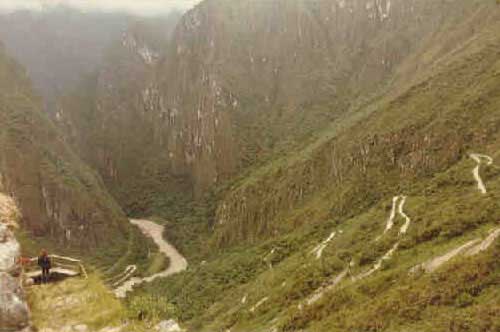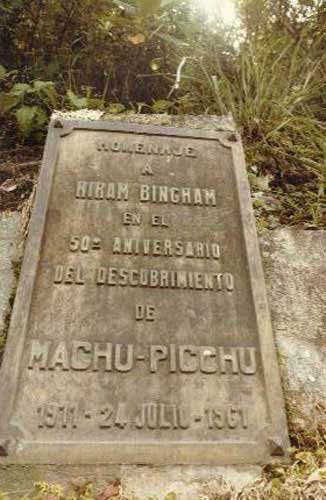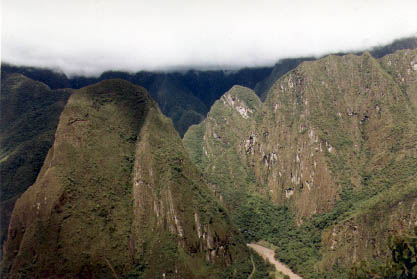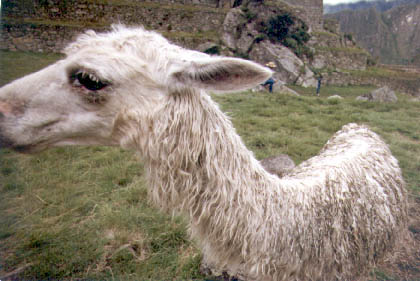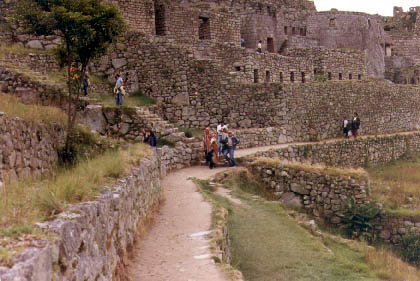
Pyramids of the Sun and Moon in Teotihuacan
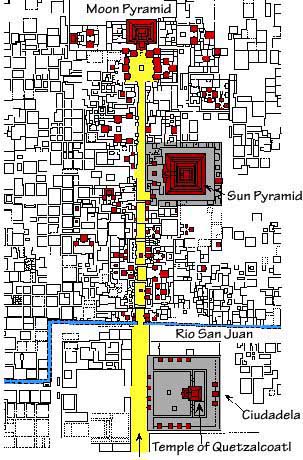
Teotihuacan was, at its height in the first half of the 1st millennium CE, the largest pre-Columbian city in the Americas. The city during its existence was larger than any European city of the same era, possibly including Rome. The civilization and cultural complex associated with the site is also referred to as Teotihuacan. Its influence spread throughout Mesoamerica; evidence of Teotihuacano presence, if not outright political and economic control, can be seen at numerous sites in Veracruz and the Maya region. The city was located in what is now the San Juan Teotihuacán municipality in the State of México, Mexico, approximately 40 km (24.8 mi) northeast of Mexico City. It covers a total surface area of 83 kms and was made a UNESCO World Heritage Site in 1987.
The early history of Teotihuacan is quite mysterious, and the origin of its founders is debated. For many years, archaeologists believed it was built by the Toltec. This belief was based on colonial period texts such as the Florentine Codex which attributed the site to the Toltecs. However, the Nahuatl word "Toltec" generally means "craftsman of the highest level" and may not always refer to the archaeological Toltec civilization centered at Tula, Hidalgo. Since Toltec civilization flourished centuries after Teotihuacan, they cannot be understood as the city's founders.
In the Late Formative period, a number of urban centers arose in central Mexico. The most prominent of these appears to have been Cuicuilco, on the southern shore of Lake Texcoco. Scholars have speculated that the eruption of the Xitle volcano may have prompted a mass emigration out of the central valley and into the Teotihuacan valley. These settlers may have founded and/or accelerated the growth of Teotihuacan.
Other scholars have put forth the Totonac people as the founders of Teotihuacan, and the debate continues to this day. There is evidence that at least some of the people living in Teotihuacan came from areas influenced by the Teotihuacano civilization, including the Zapotec, Mixtec and Maya peoples. The culture and architecture of Teotihuacan was influenced by the Olmec people, who are considered to be the "mother civilization" of Mesoamerica. The earliest buildings at Teotihuacan date to about 200 BCE, and the largest pyramid, the Pyramid of the Sun, was completed by 100 CE.
The Pyramid of the Sun 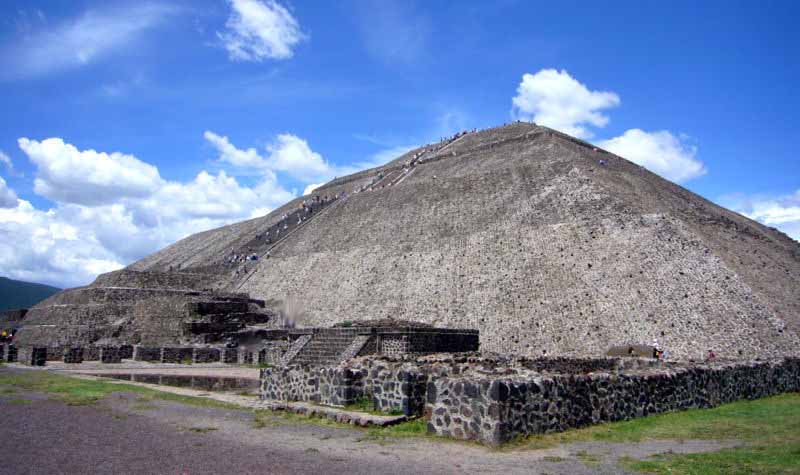
The Pyramid of the Sun is the largest building in Teotihuacán and one of the largest in Mesoamerica. Found along the Avenue of the Dead, in between the Pyramid of the Moon and the Ciudadela, and in the shadow of the massive mountain Cerro Gordo, the pyramid is part of a large complex in the heart of the city.
The name Pyramid of the Sun comes from the Aztecs, who visited the city of Teotihuacán centuries after it was abandoned; the name given to the pyramid by the Teotihuacanos is unknown. It was constructed in two phases. The first construction stage, around 100 A.D., brought the pyramid to nearly the size it is today. The second round of construction resulted in its completed size of 738 feet (225 meters) across and 246 feet (75 meters) high, making it the third largest pyramid in the world behind the Great Pyramid of Cholula and The Great Pyramid. The second phase also saw the construction of an altar atop of the pyramid, which has not survived into modern times. The Adosada platform was added to the pyramid in the early third century, at around the same time that the Ciudadela and Temple of the Feathered Serpent, Teotihuacan Pyramid of the Feathered Serpent were constructed.
Over the structure the ancient Teotihuacanos finished their pyramid with lime plaster imported from surrounding areas, on which they painted brilliantly colored murals. While the pyramid has endured for centuries, the paint and plaster have not and are no longer visible. Few images are thought to have been included in the mural decorations on the sides of the pyramid. Jaguar heads and paws, stars, and snake rattles are among the few images associated with the pyramids.
It is thought that the pyramid venerated a deity within Teotihuacan society but the destruction of the temple on top of the pyramid, by both deliberate and natural forces prior to the archaeological study of the site, has so far prevented identification of the pyramid with any particular deity. Some scholars have suggested that the deity of the pyramid was the Great Goddess, one of two major Teotihuacan deities and one of the few goddesses in ancient Mesoamerica. However, little evidence exists to support this theory.
Modern investigations
The first major archaeological excavation of the site was done by Leopoldo Batres in 1906. Batres supervised restoration of the Pyramid for the 1910 centennial of Mexican independence. Some aspects of Batres' reconstruction of the pyramid have been questioned by later archaeologists. Subsequent excavations of Teotihuacan have continued to the present. In 1925 Pedro Dosal discovered skeletons at the 4 corners of the foundations of the temple, which he interpreted as human sacrifices at the dedication of the temple.
Structure location and orientation
The orientation of the structure may hold some anthropological significance. The pyramid is oriented slightly northwest of the horizon point of the setting sun on two days a year, August 12 and April 29, which are about one divinatory calendar year apart for the Teotihuacanos. The day of August 12 is significant because it would have marked the date of the beginning of the present era and the initial day of the Maya long count calendar. In addition, many important astrological events can be viewed from the location of the pyramid that are important in terms of both agriculture and belief systems of the ancient society.
The pyramid was built over a man-made tunnel leading to a "cave" located six meters down beneath the center of the structure. Originally this was believed to be a naturally formed lava tube cave and interpreted as possibly the place of Chicomoztoc, the place of human origin according to Nahua legends. More recent excavations have suggested that the space is man-made instead, and could have served as a royal tomb. In 2008 scientists used muon detectors to try to find other chambers within the interior of the pyramid, but substantial looting has prevented the discovery of a function for the chambers in Teotihuacan society.
Recovered artifacts
Only a few caches of artifacts have been found in and around the pyramid. Obsidian arrowheads and human figurines have been discovered inside the pyramid and similar objects have been found at the nearby Pyramid of the Moon and Pyramid of the Feathered Serpent in the Ciudadela. These objects may have represented sacrificial victims. In addition, burial sites of children have been found in excavations at the corners of the pyramid. It is believed that these burials were part of a sacrificial ritual dedicating the building of the pyramid.
Temple of the Feathered Serpent

The "Temple of the Feathered Serpent" of Teotihuacan is an important religious and political[citation needed] center of the city. The Pyramid of the Feathered Serpent has revealed a great deal about religious ceremonies, burials, and politics in ancient Mesoamerica for the site of Teotihuacan. The structure contains some of the earliest-known representations of the Mesoamerican "plumed serpent" deity figure, most generally known by the term Quetzalcoatl, from the Nahuatl language of the much-later Aztec peoples.
The Feathered Serpent Pyramid is located at the Pre-Columbian site of Teotihuacán, which was at one time the largest city in the western hemisphere. The Feathered Serpent Pyramid is located in the Ciudadela at the South end of the Avenue of the Dead, a long avenue which is surrounded by platforms displaying the talud-tablero architectural style.
The Ciudadela
The Ciudadela is a Spanish term first used when the Spanish conquistadors arrived at Teotihuacán. It is a structure with high walls and a large courtyard that surrounds the Pyramid of the Feathered Serpent. The Ciudadela¹s courtyard is massive enough that it could house the entire adult population of Teotihuacán within its walls, which was estimated to be one hundred to two hundred thousand people during its peak. Within the Ciudadela there are several monumental structures, including the Pyramid of the Feathered Serpent, two mansions on the North and South side of the pyramid and the Adosada platform. The Adosada platform is located on the front, West side of the Pyramid of the Feathered Serpent, blocking its front view.
Architecture
The Feathered Serpent Pyramid is built in the talud-tablero style, with several platforms forming the pyramid. In between every platform there is a wall where a feathered serpent¹s head sticks outward. Its body wraps around the entire pyramid. Along with the feathered serpent there is also another figure that some believe is a representation of a crocodile or a representation of the deity Tlaloc. These figures alternate around the pyramid. In the eyes of these figures there is a spot for obsidian glass to be put in, so when the light hits, its eyes would glimmer. In between the heads a row of three shells can be found, showing that the people of Teotihuacán were trading with people along the Mexican coast. In antiquity the entire pyramid was painted. Today it is hidden by the adosada platform built in the 4th century hinting at political restructurisation of Teotihuacan during that time.
Burials at the Pyramid of the Feathered Serpent
The people of Teotihuacan believed in ritual sacrifice to satisfy the gods. Multiple burials were found at the pyramid, and it is believed that they were sacrificed as part of the dedication of the temple. The numbers of the burials are 4, 8, 9, 13, 18, and 20; these numbers represent significant ideology in Mesoamerica. There are four directions in the world, nine layers of their underworld, thirteen layers of heaven and earth, and a ritual calendar of thirteen months of twenty days or two hundred and sixty day calendar, and a solar calendar of eighteen months of twenty days.
Relation to the Calendar
As stated above there was a correlation between the Pyramid of the Feathered Serpent and a calendar for the people of Teotihuacán. The pyramid also is thought to contain two hundred and sixty feathered serpent heads between the platforms. Each of these feathered serpents also contains an open area in its mouth. This open area is big enough to put a place holder in. Thus, it is believed that the people of Teotihuacán would move this place marker around the pyramid to represent the ritual calendar. When a spiritual day would arrive the people would gather within the walls of the Ciudadela and celebrate the ritual.
Political influences
The Pyramid of the Feathered Serpent was not only a religious center but also a political center as well. The rulers of Teotihuacán were not only the leaders of men; they were also the spiritual leaders of the city. The two mansions near the pyramid are thought to have been occupied by powerful families. An interesting feature of the Feathered Serpent Pyramid is that there are examples of a shift in power or ideology in Teotihuacán and for the Pyramid itself. The construction of the Adosada platform came much later than the Feathered Serpent Pyramid. The Adosada platform is built directly in front of the pyramid and blocks its front view. Thus, it is thought that the political leaders lost favor or that the ideology of the Feathered Serpent Pyramid lost virtue and was covered up by the Adosada.
Teotihuacan reached its zenith between 150 and 450, when it was the center of a powerful culture whose influence extended through much of the Mesoamerican region. At its height the city covered over 30 kms (over 11 1/2 square miles), and probably housed a population of over 150,000 people, possibly as many as 250,000. Various districts in the city housed people from across the Teotihuacano region of influence that spread south as far as Guatemala. Notably absent from the city are fortifications and military structures.
The nature of political and cultural interactions between Teotihuacan and the centers of the Maya region (as well as elsewhere in Mesoamerica) has been a long-standing and significant area for debate in Mesoamerican scholarship. It is clearly established that substantial exchange and interaction occurred over the centuries from the Terminal Preclassic to the Mid Classic period, and that "Teotihuacan-inspired ideologies" and motifs persisted at Maya centers into the Late Classic long after Teotihuacan itself had declined.
However, there are several schools of thought contending the extent and degree of Teotihuacano influence, which range from a direct and even militaristic dominance, to one where the adoption of 'foreign' traits was part of a selective, conscious and bi-directional cultural diffusion. But because of new discoveries, it now seems that Teotihuacan was not much more different from the later empires, such as the Toltec and Aztec. It is believed that Teotihuacán had a major influence on the Preclassic and Classic Maya, most likely by conquering several Maya centers and regions including Tikal and the region of Peten, and influencing Maya culture.
Architectural styles prominent at Teotihuacan are also found widely dispersed at a number of distant Mesoamerican sites, which some researchers have interpreted as evidence for Teotihuacan's far-reaching interactions and political or militaristic dominance.
A style that has been particularly associated with Teotihuacan is known as talud-tablero, in which an inwards-sloping external side of a structure (talud) is surmounted by a rectangular panel (tablero). Variants of the generic style are found in a number of Maya region sites, including Tikal, Kaminaljuyu, Copan, Becan, and Oxkintok, and particularly in the Petén Basin and the central Guatemalan highlands.
However, it has been established that the talud-tablero style pre-dates its earliest appearance at Teotihuacan in the Early Classic period, and instead seems to have first originated in the Tlaxcala-Puebla region during the Preclassic.
Analyses have also been able to trace the development into local variants of the talud-tablero style at sites such as Tikal, where its use precedes the 5th-century appearance of iconographic motifs shared with Teotihuacan. Thus it appears that the talud-tablero style disseminated through Mesoamerica generally from the end of the Preclassic and not specifically or only via Teotihuacano influence. It is unclear how or from where the style spread into the Maya region.
The city was a center of industry, home to many potters, jewelers and craftsmen. Teotihuacan is known for producing a great number of obsidian artifacts. Unfortunately no ancient Teotihuacano non-ideographic texts are known to exist (or known to have existed), but mentions of the city in inscriptions from Maya cities show that Teotihuacan nobility travelled to and perhaps conquered local rulers as far away as Honduras. Maya inscriptions mention an individual nicknamed by scholars as "Spearthrower Owl", apparently ruler of Teotihuacan, who reigned for over 60 years and installed his relatives as rulers of Tikal and Uaxactun in Guatemala.
Most of what we infer about the culture at Teotihuacan comes from the murals that adorn the site (and others, like the Wagner Murals, found in private collections) and from hieroglyphic inscriptions made by the Maya describing their encounters with Teotihuacano conquerors. The creation of murals, perhaps tens of thousands of murals, reached its height between 450 and 650 CE. The painters' artistry was unrivalled in Mesoamerica and has been compared with that of Florence, Italy.
Teotihuacano culture
People
There is archaeological evidence that Teotihuacan was a multi-ethnic city, with distinct Zapotec, Mixtec, Maya and what seem to be Nahua quarters. The Totonacs have always maintained that they were the ones who built it, a story that was corroborated later by the Aztecs.
Language
In his 2001 paper,[17] Terrence Kaufman presents linguistic evidence suggesting that an important ethnic group in Teotihuacán was of Totonacan and/or Mixe-Zoquean linguistic affiliation. He uses this to explain general influences from Totonacan and Mixe-Zoquean languages in many other Mesoamerican languages many of which do not have any known history of contact with either of the above-mentioned groups.
Religion
The religion of Teotihuacan is similar to those of other Mesoamerican cultures. Many of the same gods were worshiped, including the Feathered Serpent and The Rain god. Teotihuacan was a major religious center, and the priests probably had a great deal of political power. As with other Mesoamerican cultures, Teotihuacanos practiced human sacrifice. Human bodies and animal sacrifices have been found during excavations of the pyramids at Teotihuacan; it is believed that when the buildings were expanded, sacrifices were made to dedicate the new building. The victims were probably enemy warriors captured in battle and then brought to the city to be ritually sacrificed so the city could prosper. Some were decapitated, some had their hearts removed, others were killed by being hit several times over the head and some were even buried alive. Animals that were considered sacred and represented mythical powers and military might were also buried alive but imprisoned in cages: cougars, a wolf, eagles, a falcon, an owl, and even venomous snakes.
Site Layout
The city's broad central avenue, called "Avenue of the Dead" (a translation from its Nahuatl name Miccoatli), is flanked by impressive ceremonial architecture, including the immense Pyramid of the Sun (second largest in the New World after the Great Pyramid of Cholula) and the Pyramid of the Moon. Along the Avenue of the Dead are many smaller talud-tablero platforms. The Aztecs believed they were tombs, inspiring the name of the avenue. Now they are known to be ceremonial platforms that were topped with temples. Further down the Avenue of the Dead is the area known as the Citadel, containing the ruined Temple of the Feathered Serpent. This area was a large plaza surrounded by temples that formed the religious and political center of the city. The name "Citadel" was given to it by the Spanish, who believed it was a fort. Most of the common people lived in large apartment buildings spread across the city. Many of the buildings contained workshops that produced pottery and other goods.
The geographical layout of Teotihuacan is a good example of the Mesoamerican tradition of planning cities, settlements and buildings as a representation of the Teotihuacano view of the Universe. Its urban grid is aligned to precisely 15.5º east of North. The Street of the Dead, in particular, seems to line up with Cerro Gordo to the north of the Pyramid of the Moon. Pecked-cross circles throughout the city and in the surrounding regions indicate how the grid was managed over long distances.
Archaeological site
Knowledge of the huge ruins of Teotihuacan was never lost. After the fall of the city, various squatters lived on the site. During Aztec times, the city was a place of pilgrimage and identified with the myth of Tollan, the place where the sun was created. Teotihuacán astonished the Spanish conquistadores during the post-conquest era. Today Teotihuacan is one of the most noted archaeological attractions in Mexico.
Excavations and investigations
Minor archaeological excavations were conducted in the 19th century, and in 1905 major projects of excavation and restoration began under archaeologist Leopoldo Batres. The Pyramid of the Sun was restored to celebrate the centennial of Mexican Independence in 1910. Excavations at the Ciudadela were carried out in the 1920s, supervised by Manuel Gamio; other sections of the site were excavated in the 1940s and 50s. The first site-wide project of restoration and excavation was carried out by INAH from 1960-65 and supervised by Jorge Acosta. This focused on clearing the Street of the Dead, consolidating the structures facing it, and excavating the Palace of Quetzalpapalotl.
During the installation of a 'sound and light' show in 1971, the entrance to a tunnel and cave system underneath the Pyramid of the Sun was accidentally discovered. Long thought to be a natural cave, more recent examinations have established the tunnel was entirely artificial. The interior of Pyramid of the Sun has never been fully excavated.
Another major program of excavation and restoration was carried out 1980-82 at the Pyramid of the Feathered Serpent and the Street of the Dead Complex. Most recently, a series of excavations at the Pyramid of the Moon have greatly expanded evidence of cultural practices.
Collapse
It was previously believed that sometime during the 7th or 8th centuries, the city was sacked and burned by invaders, possibly the Toltecs. More recent evidence, however, seems to indicate that the burning was limited to the structures and dwellings associated primarily with the elite class. Some see this as evidence that the burning was from an internal uprising and that the invasion theory is flawed due to the fact that early archaeological work on the city was focused exclusively on the palaces and temples, places used by the elites, and because all of these sites showed burning, archaeologists concluded that the whole city was burned. Instead, it is now known that the destruction in the city was focused on major civic structures along the Avenue of the Dead.
Some statues seem to have been destroyed in a methodical way, their fragments dispersed. Evidence for population decline beginning around the 6th century lends some support to the internal unrest hypothesis. The decline of Teotihucán has been correlated with the droughts related to the Climate changes of 535-536 CE. This theory is supported by the archaeological remains that show a rise in the percentage of juvenile skeletons with evidence of malnutrition during the 6th century. This does not conflict with either of the above theories however since both increased warfare and internal unrest can also be effects of a general period of drought and famine.
Other nearby centers such as Cholula, Xochicalco, and Cacaxtla attempted to fill the powerful vacuum left by Teotihuacan's decline. They may have aligned themselves against Teotihuacan in an attempt to reduce its influence and power. The art and architecture at these sites shows an interest in emulating Teotihuacán forms, but also a more eclectic mix of motifs and iconography from other parts of Mesoamerica, particularly the Maya region.
Pyramid of the Moon Photo Gallery
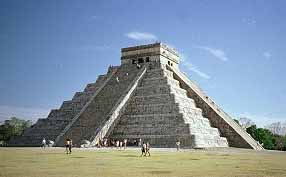
Pyramids and Temples of Mesoamerica
ShareThis
PYRAMID INDEX
SACRED PLACES AND TEACHINGS INDEX
ANCIENT CIVILIZATIONS INDEX
ALPHABETICAL INDEX OF ALL FILES
CRYSTALINKS MAIN PAGE
PSYCHIC READING WITH ELLIE
2012 THE ALCHEMY OF TIME
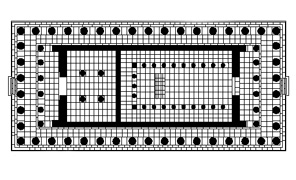




























 the bottom of the canyon, but near the top, you can find trilobites, and sometimes even footprints or so of reptiles.
the bottom of the canyon, but near the top, you can find trilobites, and sometimes even footprints or so of reptiles.









